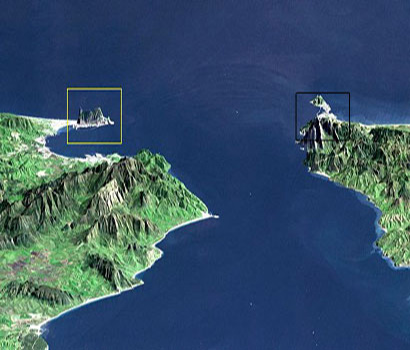The accurate description that Plato makes about legendary island of Atlantis is one of the great myths fueled by science fiction literature that might have a scientific explanation. The earliest references to Atlantis dialogues appear in the texts of the Greek philosopher Plato. In them, Critias, a disciple of Socrates, tells a story as true; it goes nine thousand years back in time to tell how the Athenians stopped the advance of the empire of Atlantis, warlike inhabitants of a large island called Atlantis, which allegedly was located opposite to the Pillars of Heracles and shortly after the Athenian victory got lost into the sea due to an earthquake and an ensuing great flood. According to the Greek Philosopher Plato, the Atlantis Gods punished them for their pride and doomed them to disappear, sinking them under the sea.
It is the lost continent which some researches are still looking for. Strabo, in the first century b.C. seems to have shared with Posidonius, (135 - 51 b.C.), the opinion about the story of Plato, regarding it as not a fiction. In Spain, since 2005, a group of scientists have been looking for the remains of the Kingdom of Tartessos in the Doñana National Park, with the assumption that the Atlantis historical remains could be found there. In fact, Plato situated the island in front of the Pillars of Heracles located in the Strait of Gibraltar. The Pillar of Hercules or Heracles, were a legendary element of mythological origin and marked both the limits of the known world and the last frontier for the ancient navigators of the Mediterranean Sea.
The Greeks knew well the Mediterranean Sea. Although given to the expanse of the Atlantic Ocean their knowledge of what lay here was in all cases, very limited, giving rise to legends. At the mouth of the Guadalquivir River, in the marshes of the Doñana National Park, has been found strange geological structures that could have been altered by humans and the alterations of which match the ones carried out in the Tartessian influence area.
Moreover, both the dunes and the sea in the area have been probed and by studying the sediments proved that there occurred a Tsunami 2.500 years b.C. The outcome of which altered and changed the whole area and might also have wiped out all the peoples living in this area. Nothing conclusive but perhaps said disaster was transmitted orally, thus giving rise to the legend or myth of Atlantis.
In any case it is important to bear in mind that Plato in his books used to combine reality with fiction and that he could have taken advantage of this legend to recreate some of his texts that gave rise to the Atlantis people. Hercules, a character from Greek mythology, according to legend, separated Europe from Africa across the Strait of Gibraltar and marked his territory with two columns. On both sides of the Strait of Gibraltar, it can be seen with the naked eye; on the foothills of the Atlas, a white mountain, known as Mount Musa of 839 meters and on the Peninsular side (the other column would be) the Rock of Gibraltar which is a monolithic limestone promontory 426 meters high. On the African side, a mountain range system runs along 2400 km, northwest Africa, from Tunisia to Morocco and Algeria, known as Atlas and High Atlas, in the highlands of which live small populations primarily composed of ethnic Berbers from Morocco and Algeria .
|
 |